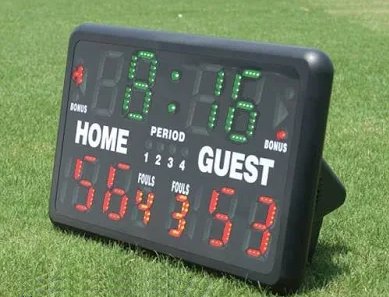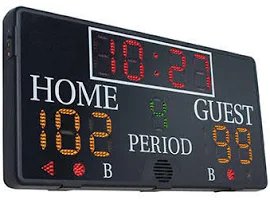

SunBright EM® Displays
Brilliant and Comfortable, for Everyone Viewing
ScoreTronics scoreboards use SunBright EM® displays instead of LEDs. SunBright EM® displays use electromagnetic technology to reflect the abundant energy from the sun and other ambient light sources to produce displays that are brilliant in direct sunlight and superior to LED in other lighting conditions.
LED's work by using a pin-head sized piece of material to produce a tiny amount of light and then narrowly focusing it forward. This results in over-bright conditions (often uncomfortable and distracting) when viewed directly head-on, and inadequate brightness (difficult to see and drowned out by sunlight) when viewed at angles other than head-on.
SunBright EM® displays have uniform, constant brightness at all viewing angles. And because they are getting their optical brightness from the sun and ambient light, they are inherently self-adjusting to all brightness conditions--from direct sunlight to overcast. They're always comfortably bright, and at all angles--not "get out your sun glasses" distracting at some angles and "what does it say?" at other angles.
You'll notice that LED scoreboard displays are almost always
photographed head-on (directly in front). This is where the LED is the
brightest, but the brightness falls off as you view at increasing angles to the
side. In scoreboard applications, especially in portables which are viewed
closer, only a small number of people view the unit head-on, and the
majority of people are viewing the unit at angles, which is where LED displays
are at their worst. You almost never see LED Scoreboards photographed at angles,
where the majority of the audience is viewing. (When you do find a picture
of an LED scoreboard at an angle, it is usually photoshopped to enhance the
display brightness to a fake level) We found a couple real (non-fake)
angle pictures of LED scoreboards on the web (displayed below)--you can judge
for yourself.
Quality Font Visibility
SunBright EM®
displays use large rectangular line segments that make the numbers much easier
to read than a small number of tiny points of light (as few as three) trying to simulate a wide
line in an LED display. The physics and optics of the human eye
allow for numbers to be visible at 40 feet per inch tall of display height, meaning
that a 4" tall display has a visibility of 160 feet for average vision, but
this applies only to displays with fully formed characters, like a doctors' eye
chart. The crude approximation of characters by using a few points
of light (LEDs) makes LED displays much more difficult to read, especially at
a distance,
and 40 feet per inch visibility with LED displays is simply
not possible.
Long Life
Some people think that LED's last forever. This is simply not true. All LEDs will significantly fade in brightness over time, and the industry standard specification on LED brightness fade is "Down to 50% brightness in 50,000 hours, when operated at room temperature (68F)". The brightness degradation gets much faster if the LED is operated at above room temperature, which is common with LED's in enclosures, like scoreboards. LEDs are NOT LIFETIME displays. To observe this, look at an LED display in a public elevator LED display that has been in service a number of years--you'll notice that the LED segments that are used the most (like floor #1) are much dimmer than the lesser-used segments in the display.
SunBright EM® displays produce constant brightness over their lifetime. The only change over time is a slight fading of the yellow color towards white, which is still very visible against the black background. The mechanisms that move the segments have cycle lives in the millions of cycles, and it is not possible in any normal scoreboard application to wear one out. If you manage to become the first person to wear out a SunBright EM® display in a scoreboard application, we will repair or replace it for free, regardless of age.
Green
No, the displays aren't colored green (but we could make them colored green if you wanted). They are "Green" environmentally. SunBright EM® displays electromagnetic technology uses NO power (zero, nada, zip) when they are displaying a static (constant) number, and they take only a tiny amount of energy to change the display when a change is needed. Compare this to LEDs, which consume power at all times to display a number. You can see the effect of the nearly-zero power consumption of SunBright® displays in our scoreboard battery life specifications, which are the highest by far in the industry. (500 hours of running time on a set of AA batteries on the baseball model)
SunBright EM® Disadvantages
SunBright EM® displays
have only one disadvantage to LEDs--cost. Electromagnetic display
technology is more expensive to make than LEDs. LEDs are made by the
millions in China, India, Pakistan, and Taiwan (there no US producers of LEDs
for scoreboards), verses SunBright® EM
displays being made by the thousands in the United States. The goal at
ScoreTronics is to build the BEST scoreboard, even it it has to cost a little
more. Our thousands of customers, without exception, feel that it's money
well spent.
PICTURES OF LED SCOREBOARDS VIEWED AT ANGLES (NOT HEAD-ON)
The pictures below were found on the web, and are un-retouched except to remove the brand names. You can see that the left picture was taken in partial sunlight (not full sunlight)--you can tell this from the shadows which would be would be darker if it was in full sunlight. The right picture was taken in the daytime (you can see the sky reflecting off the front panel), but not in full sun. Both are taken from a real life viewing angle--in other words, not head-on. Notice that when LED scoreboards are viewed at angles (not head-on), they loose their contrast and visibility. (Notice that the "1" in the clock on the left picture is barely bright enough and you can't really read the period display on the right picture--we think it is a "9", and the right digit of the right clock "7" is hard to read). If these units were viewed at these angles in full daytime sunlight, they would be even more difficult to read. It's an inherent issue with outdoor LED displays, but not with EM displays. EM displays stay the same brightness no matter what the viewing angle.

